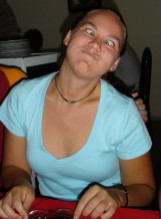Artisans in Guatajiagua
On the opposite side of El Salvador in Guatajiagua lives another community of artisans. Their specialty is black pottery. My artisans have long had an interest in how it was made. Thus, we some of the additional funds from the project, John (another volunteer) and I organized a trip for four of my artisans.
We left Friday, February 29th at about 6 a.m. for the 5 hour pick-up ride out. After getting settled into the hotel and eating lunch, we started looking through a few ‘tallers’ or shops.
In the first one we saw how they prepare their clay. The first step is to grind it up, then mix it with water and finally push is through a press. This allows their clay to be extremely fine and stronger. In contrast, my artisans put the clay out in the middle of the street to allow cars to run over it.
We also saw how they wore starting to integrate molds into their work. It was interesting to hear how both groups of artisans liked the advantages that molds or pottery wheels could offer – but were also nervous about future generations losing the skill of hand made pottery.
Next up was a store set-up and run by a few artisans. A number of my artisans have long thought of opening a store so it was nice that they could hear how others had decided to set theirs up.
After the store, we went to a Nina Carmen’s taller. Hers is unique because of the work her son does – he works almost exclusively on the pottery wheel. Each of my artisans got to work on the week for at least 45 minutes under his instruction and they loved it! My artisans have just recently been given a pottery wheel, so this was a way to spark interest and give them the confidence to approach it as a tool for their own work.
From there we walked over to another taller where they were firing their pieces. Now the kilns in Guatajiagua are very different from the kilns in Santo Domingo de Guzman. They are domed shaped and the fire goes into the same chamber as the pieces, not below like ours.
Here is where we saw how they actually make black pottery. After forming the piece, they let it dry. At this point the pieces are an ashen white. When they are dry, they are fired and turn a brighter white. Once the pieces are done being cooked, they let the fire continue as they pull out pieces one by one. This is done with a long stick looped through a handle on the piece. They move the piece over to a station where they dump a natural dye onto it. The dye is made from boiling seeds from a tree. (Forgive me, but I forget the name of the tree). Surprisingly, the pieces don’t crack from the rapid change in temperature. Afterward, they are set aside to dry. It was fascinating to watch.
That brings us to about 7pmish, so we left to go grab dinner and settle in for the night.
The next morning was spent completely at Nina Carmen’s taller where the women got another hour each at the pottery wheel with instruction.
We left around 1pm – after saying good-bye and saying thanks.
I really think it was a great trip. The women bought some of the seeds to see if they could use it on their own pieces and are now talking about setting up trainings for the pottery wheel. It also gave them different ideas of what to mix their clay with – for example with only sand and not white dirt.
Next up is having the ‘instructor’ come down and stay in Santo Doming de Guzman for a week with the support of ADEL (another NGO)



















